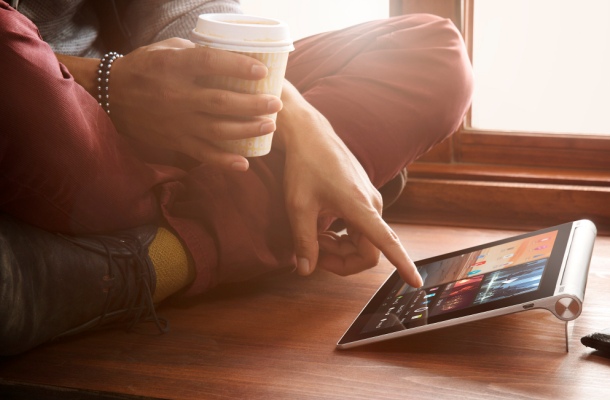Software Experience
The Yoga comes running Android 4.2.2, which isn;t the latest revision of Jelly Bean, but it’s pretty close. It will be interesting to see if the tablets will update to 4.3 or even 4.4 (Kit Kat). Lenovo skinned the Yoga’s version of Android, but not as heavily as some tablets. Gone is the “launch wheel” as the central element of the screen, and it won’t be missed. A more puzzling design choice was Lenovo’s removal of the app drawer, gone from both the upper left as well as the app dock. Instead, a swipe to the left reveals all your apps. This may be fine for people coming from an iPad, but it’s a major shift in workflow for Android users. Especially confusing is the fact that the app screen feels like a home screen, but you’ll realize it’s not when you try to make a folder on it. When you move two apps from the app screen to the first home page to make a folder, they vanish from the app screen, which definitely isn’t standard behavior for an app drawer. It’s confusing and a little annoying. Speaking of folders, clicking them opens them in full screen. We would have included a screenshot, but Lenovo seems to have removed that functionality from Android.

My face when I realized that.
Update: Lenovo reached out to let me know that the functionality was still there. The issue was with my review unit. Good to know!
Speaking of apps, Lenovo’s early Android tablets were a textbook case of pre-loading. There was even a dedicated Lenovo app store in addition to Google Play. The Yoga has some apps pre-loaded, but it’s a much smaller batch. In addition to the expected Google apps (Chrome, Gmail, Hangouts, Maps, Play, YouTube, and some also-rans), Lenovo also loaded FileBrowser, a tweaked camera app, a basic audio recorder, a feature guide, the manual, an app for managing the Dolby audio, a power management app, AccuWeather, Skype, a download link for Norton Mobile Security (don’t do it!), and a Kindle App. That seems like a lot, but it’s less than we’ve seen on other systems. Also worth mentioning are the few apps that duplicated the job of other apps: EZ File Explorer, Route 66 Navigate, and a generic browser. Some apps could be deleted (Navigate), while others could not (Norton).
The overall experience was a good load of apps, but the decision to change the UI in the intuitive manner done here is baffling. Dedicated Android users are going to need to seriously retrain their muscle memory.
Performance
A quad core chip running at 1.2 GHz is going to make most users insanely happy. There are faster chips out there (The Samsung Note 10.1 has a 1.4 GHz chip), but in terms of day-to-day use, there’s not going to be that much of a difference.
What does make a huge difference for any tablet is the screen. Any 10″ tablet that comes out in 2013 that doesn’t have at least HD graphics can be considered a failure. Both Lenovo Yogas have a 1280 x 800 resolution, giving you 149 PPI. That’s better than the iPad 2 (132 PPI), but falls flat before the iPad Air (264 PPI), th 2014 edition of the Nexus 10.1 (300 PPI), or even the Nexus 1o (299 PPI). In terms of real world use, movies and games looked fine, but one can’t help feeling they could have looked better. The choice of a lower resolution screen may have been to keep the price down, but with a multimedia tablet, most would likely be willing to pay a bit more. One area the screen didn’t disappoint was the viewing angle. This is certainly a tablet that more than one person can watch a movie on.



Comments are closed.